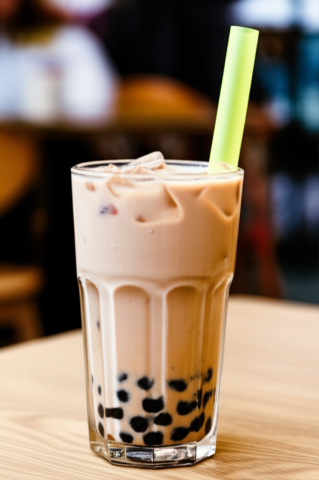
Boba Tea - What is it?
Boba tea, also known as bubble tea, pearl milk tea, or tapioca tea, is a delicious and refreshing beverage that has taken the world by storm. Its popularity stems from its customizable nature, unique textures, and delightful flavors. But what exactly is it?
The Basics: Tea, Milk, and Pearls
At its core, boba tea is a combination of tea, milk (or a milk alternative), and chewy tapioca pearls. The tea base can vary widely, from classic black tea and green tea to more adventurous options like oolong, jasmine, or fruit-infused teas. Milk adds creaminess and sweetness, while the tapioca pearls provide a fun, textural contrast. These pearls, often called "boba," are small, spherical balls made from tapioca starch.
The Variations: A World of Flavor
The beauty of boba tea lies in its incredible versatility. While the foundational elements remain consistent, the possibilities for customization are virtually endless. Here are some key variations:
Tea Base:
- Black Tea: A strong, robust base, often providing a malty flavor.
- Green Tea: Lighter and more subtly flavored, with a slightly vegetal note.
- Oolong Tea: A medium-bodied tea with a complex, aromatic profile.
- Fruit Teas: Infused with various fruits like mango, strawberry, or passionfruit, adding bright and sweet flavors.
- Milk Teas: Tea combined with milk (dairy or non-dairy) for a creamy base.
Milk Options:
- Dairy Milk: Traditional cow's milk provides a classic creamy texture and sweetness.
- Non-Dairy Milk: Soy milk, almond milk, oat milk, and coconut milk offer dairy-free alternatives, each with its unique flavor profile.
Sweeteners:
- Sugar: Simple sugar is a common sweetener, often customizable to your preference.
- Honey: A natural sweetener with a distinct floral flavor.
- Brown Sugar: Adds a caramel-like sweetness and complexity.
- Artificial Sweeteners: Some boba tea shops offer artificial sweeteners for those watching their sugar intake.
Toppings Beyond Boba:
While boba pearls are the hallmark of this drink, many other toppings can be added to enhance the experience.
- Popping Boba: Small, juice-filled spheres that burst in your mouth, adding a surprising fruity flavor and juicy texture.
- Puddings: Creamy pudding adds a decadent touch, complementing the tea and milk.
- Jelly: Various fruit jellies add contrasting textures and flavors.
- Cream Cheese Mousse: Adds a savory and creamy contrast to the sweetness.
- Coconut Jelly: Adds a tropical and chewy element.
The Making of Boba Tea: A Simple Process
While the seemingly endless variations might seem intimidating, the basic process of making boba tea is quite simple. It typically involves brewing the tea, mixing it with milk and sweetener, and then adding the cooked tapioca pearls. The tapioca pearls require a bit of preparation; they need to be cooked in boiling water for a specific amount of time to achieve the perfect chewy texture. The entire process is usually completed within a few minutes, making it a quick and efficient drink to prepare.
The Tapioca Pearls: A Closer Look
The tapioca pearls, the star of the show, are the chewy, black spheres that give boba tea its signature texture. Made from tapioca starch, they are cooked until they become soft and chewy, but not mushy. Their mild, almost neutral flavor allows the other ingredients to shine. The cooking process is crucial for getting the perfect consistency; undercooked pearls will be hard, while overcooked ones will be too soft and potentially fall apart.
The Cultural Significance of Boba Tea
Boba tea's origins trace back to Taiwan in the 1980s. It quickly gained immense popularity in Taiwan and soon spread throughout Asia and then to the rest of the world. It has become a significant part of many cultures, serving as a social drink, a refreshing treat, and a symbol of modern youth culture. Boba shops are often vibrant social hubs, offering a space for people to gather and socialize while enjoying their favorite drinks. It's more than just a beverage; it's a cultural experience.
Health Considerations: Moderation is Key
Like any sugary drink, boba tea should be enjoyed in moderation. The high sugar content can contribute to weight gain and other health issues if consumed frequently. However, many shops are becoming increasingly aware of these concerns and are offering healthier options, such as sugar-free syrups and non-dairy milk alternatives. Choosing these options can significantly reduce the sugar content and make boba tea a more balanced treat.
Beyond the Drink: The Boba Tea Experience
Boba tea is more than just a drink; it's an experience. The vibrant colors, customizable flavors, and the unique texture of the boba pearls create a sensory delight. It's a drink you engage with, often requiring a wide straw to slurp up those chewy pearls. The social aspect of sharing a boba tea with friends or family adds another layer of enjoyment to the experience. It's a perfect accompaniment to conversations, study sessions, or simply a relaxing afternoon.
Exploring the World of Boba Tea: A Culinary Adventure
The journey into the world of boba tea is a culinary adventure. From the classic milk tea with boba to the more exotic fruit teas with popping boba and pudding, there's a flavor combination for everyone. Experimenting with different tea bases, milk alternatives, and toppings allows you to discover your personal preferences and create your perfect boba tea masterpiece. So, dive in and explore the delightful world of boba tea – you might just find your new favorite drink!
No comments:
Post a Comment